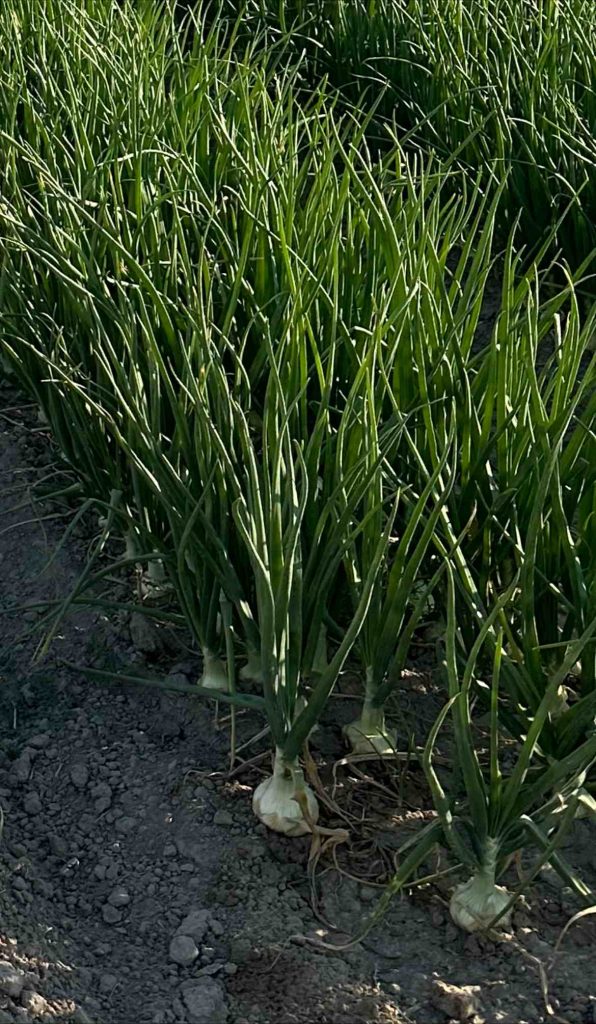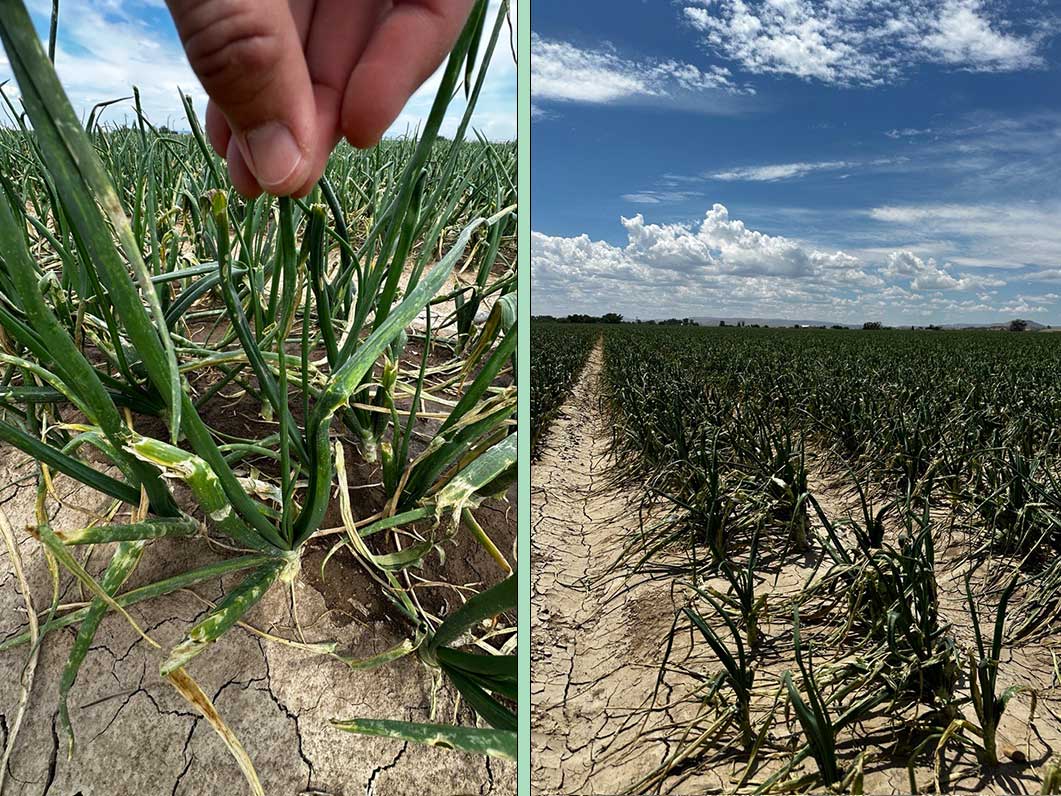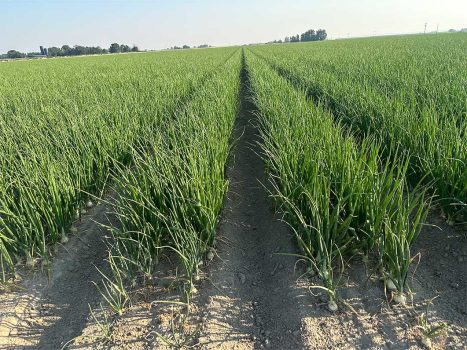
Featured images: (Left) Hail Damage with 2 New Leaves 6 days after Storm (Right) Hail Damage – tops still standing six days after the storm. Courtesy of Joe Ange with Eagle Eye Produce in Nyssa, OR
As the onion season approaches in the Treasure Valley area of Idaho and Eastern Oregon, there is a mix of optimism and resilience among local growers. Despite challenges, the outlook for the 2024 crop remains positive, with promising signs of recovery and growth.
Eagle Eye Produce: Overcoming the Microburst
Joe Ange from Eagle Eye Produce in Nyssa, Oregon, shared his perspective on the upcoming harvest. “In ID/OR we’re also seeing some really nice lots of onions that are right on track for this fall’s harvest. Overall, we’re very optimistic about the crop and looking forward to getting started in August.” Reflecting on a recent weather event, Ange noted, “In regards to the microburst we experienced here in Nyssa 2 weeks ago – first and foremost we’re glad that nobody was injured, and our thoughts are with those who had structural damage to homes, businesses, storages, and packing facilities.”
Ange described the intensity of the storm: “I’ve personally never been in a ‘named hurricane,’ but what we had in Nyssa was no less than 20 minutes of hurricane-like conditions with wind gusts reported up to 90 mph and penny-sized hail here at our office in Nyssa. At our facility in Nyssa, we had some severe damage to the roof of our packing shed and a couple of storages. We’re currently in the process of putting everything back together and expect to be operational in time for harvest and packing of the 2024-25 crop.”
Despite the damage, the resilience of the crops is evident. “The onions are showing some great resiliency – already regrowing leaves and restoring tops. Even in the harder-hit lots, we’re seeing some great promise to how the crop is progressing, and we still expect to get a quality crop, although those lots may be a bit behind schedule and likely to yield a few more medium-sized onions.”
Tamura Farms: Early Harvest and Quality Assurance
Dwayne Fisher of Tamura Farms in Wilder, Idaho, expressed confidence in their crop’s early development. “Our Idaho and Utah crop, at the moment, are ahead on our farms and for our growers. We are looking to be able to start two to three weeks earlier than we have the last three years. This is welcome news with the reported increase in acres from our region and the Northwest in general.”
Fisher also addressed the recent storm, stating, “Many have inquired on the recent storm in our valley that certainly impacted acres and facilities. We did not have any onions that were hit on our farms. The growers that got hit, I know, are working hard to restore plant health and finish out their crops. Time will tell what plays out for those acres. All indications right now are that we have an excellent crop of onions coming from our region that will supply our domestic and international demand.” Many thanks to Dwayne for providing photos. One crop photo is shown below, and the other is this week’s featured image for our Market and Crop Update.

Skeen Farms: Favorable Growing Conditions
Paul Skeen of Skeen Farms in Nyssa, Oregon, highlighted the positive growing conditions this season. “I’ll tell you what I told attendees at the June NOA meeting in Anchorage, ‘We’ve had a favorable growing season, and the onions appear to be in great shape. The storm that the area experienced on June 29th impacted a very minor percentage of the Idaho Oregon total grown acreage. They appear to be coming back nicely. We will have plenty of top-quality onions to supply all of our domestic customers’ needs and export needs as well.'”
Skeen also addressed the impact of high temperatures, noting, “The high temperatures we are currently experiencing don’t seem to be having as dramatic an effect on the onions at this point because of the good growing conditions. The onion plants have created a very nice canopy that is protecting the bulbs. We have to remember that the Snake River growing region is perfect for the Spanish Sweet onion varieties grown here. They respond well to warm days and cooler temperatures at night.”
Skeen also discussed market pressures: “We discussed at the NOA meeting the large amounts of onions coming from Mexico and Peru’s increased acreage that are coming on our market and driving markets down. We all know the American dollar is so strong that it wouldn’t matter what the price is; they will still come across the border. The pesos are 19-1 with the American dollar. The American consumer needs to know that the American farmer raises the safest product because of our regulations from USDA. Very few of the onions that come into the United States are not inspected by the USDA.”
OSU Malheur Extension: Managing Stress and Disease
Stuart Reitz, Director of OSU Malheur Extension, provided insight into the challenges faced by growers due to the storm and heat. “That was an intense storm, but maybe the silver lining is it wasn’t more widespread. For onions, the area from west of Nyssa to Anderson Corner seems to have taken the brunt of it. And within that area, some fields were damaged more extensively than others.”
Reitz emphasized the importance of timing and plant health: “Not that there is ever a good time to have a storm, but this one came at a bad time. You want as big a top as possible as the bulbs begin to grow, and the plants lost a lot of foliage. Fields I’ve seen are regrowing, but it’s the question of how much can they grow and then how big can the onions get. And it’s not just a question of size. Following storm damage, there are concerns about diseases and bulb rots. Growers have been applying fungicides and bactericides to limit disease spread, but those aren’t cures for already infected bulbs.”
Addressing the heat, Reitz added, “The heat is another stress on the plants, whether in storm-damaged fields or fields without damage. Most everything in farming revolves around the Goldilocks principle – you don’t want too much or too little of heat, nutrients, etc.; you want just the right amount. With the high daytime temperatures and having it not cool off at night, the amount of time for plant growth during the day is limited, which again translates into the bulbs not being able to get as big as they could because the plants physiologically ‘shut down’ in the heat.”
Conclusion
Despite facing significant challenges, the onion growers in the Treasure Valley area are demonstrating resilience and optimism. With careful management and favorable growing conditions, the 2024 onion crop is expected to be abundant and of high quality, meeting both domestic and international demand.



